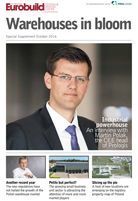Another record year for warehouses
Report
When the consultancies’ H1 reports on the warehouse market began to flow in at the beginning of the summer holidays, everything started to become clear. This year will, in all likelihood, have been another good one for the warehouse market. All the indexes have increased apart from one – vacancy. This is still hovering at around 6 pct, which is historically the lowest level for the country even though it has been accompanied by an impressive amount of new supply. According to Colliers International, in H1 the supply of warehouse space amounted to almost 660,000 sqm, constituting a growth of 35 pct on the previous year. The return to speculative development deserves particular attention. This has been quite substantial – according to CBRE as many as 52 pct of all the warehousing built in Poland is being done so without an anchor tenant in place.
Demand grows
However, developers do not seem too worried about this, due to the substantial demand, which exceeded 1.4 mln sqm in H1 – 7 pct higher than in H1 2015. According to JLL, the largest amount of space was leased around Warsaw (as much as 346,000 sqm), on the Poznań market (223,000 sqm) and the Wrocław market (181,000 sqm). In the first half of the year, the net demand in Poland amounted to 876,000 sqm – the highest H1 figure in the history of the market and an indication that 2016 will be another record year.
Logistics companies and grocery operators are the most interested segments when it comes to warehouse space. “We have been seeing a great deal of interest from international logistics companies who are relocating operations from Western Europe to Poland in order to achieve cost optimisation. Businesses that currently have production plants, particularly in Germany, are hoping for a similar effect. I think that the trend will continue, even in the face of growing labour costs in Poland,” argues Hubert Michalak, the senior vice-president and CEE managing director of Hillwood Polska. Industries directly involved in the development of computer technology are also taking an increasingly large slice of the warehouse pie for themselves. “The expected growth of e-commerce and its impact on the growth of warehouse space lease are now becoming reality,” remarks Martin Polak, the senior vice-president and regional head of Prologis in the CEE region. Those parties interested in the warehouse space provide confirmation of this. Zalando announced the construction of a 130,000 sqm distribution hub near Szczecin in the summer, while Chinese giant Alibaba has been making bolder statements about entering the Polish market. However, this is not the end of the rush for warehousing. “Companies that are consolidating and adapting their distribution systems are showing significant interest in warehouses. The DIY sector is particularly active as it is still developing in Poland, as well as the automotive industry. The rude health of the latter can be seen by the projects being carried out by Panattoni Europe for companies from this sector, including for Pilkington Automotive Poland, IFA Rotorion and Kongsberg Automotive,” argues Robert Dobrzycki, the CEO of Panattoni Europe.
The site is the key
To provide the right kind of product for warehouse users you need to find a suitable location first. The warehouse map of Poland has been dominated by the Warsaw area, central Poland, Lower and Upper Silesia, Kraków, Poznań and the TriCity for many years. But these main locations are now being joined by the Szczecin and Bydgoszcz regions. There is also new interest in smaller towns. “Panattoni Europe has warehouses almost all over Poland – in the mainstream locations of Central Poland and the Warsaw area, as well as smaller centres. We are present in Pomerania, Małopolska as well as in the east of the country and we are continuing to develop in smaller locations. We are carrying out projects in Bydgoszcz, Szczecin and Lublin – these are the new hot markets for us,” insists Robert Dobrzycki. Hillwood has adopted slightly different tactics. “We are not geographically limited in any way, but because of the scale of our projects we prefer locations that allow us to build larger projects. It’s good that there are pioneers on new markets, but this can turn out to be risky. In the east of the country there is mainly local demand for warehouse space, which might, however, not be enough to create large logistics hubs,” argues Hubert Michalak.
In addition to the direction taken by developers in Poland when it comes to locations, there has been a basic change in the law in terms of the conditions for the sale of agricultural land. The new regulations, however, are viewed by the many in the sector in a rather dim light. The head of Panattoni Europe believes that the new law on the purchase of land properties lengthens the administrative process for the implementation of projects and could even result in their construction being cancelled altogether. However, Hillwood’s manager insists that the change in the law has not affected his company in any way. He also doubts that the new regulations will have an impact on the functioning of other international institutions involved in the construction of warehousing facilities. The changes will affect those businesses professionally involved in the purchase of agricultural land, the change of its function and its later sale at a higher profit. “I believe we need to optimise the method of passing local zoning plans and the process of transforming agricultural land into investment sites. The benefits related to changes in the function of land purpose should support local authorities rather than individual units. This is of great significance for the interest of local communities,” says Hubert Michalak.
Go forward
A few months on from the amendments coming into force, one thing can be said for sure: the new regulations have not halted the growth of the Polish warehouse market, which has been growing at a rate of app. 1 mln sqm per year. “The total supply of modern warehouse and industrial space in Poland amounted to 10.58 mln sqm at the end of H1. Looking at the strong development activity, the market has a chance of exceeding the threshold of 11 mln sqm of stock this year,” believes Tomasz Olszewski, the director of the warehouse and industrial department in Central and Eastern Europe at JLL.
Monika Hapter
head of business development at DB Schenker
DB Schenker launches a few new warehouse projects every year. Our current clients are expanding, so the warehouse space we operate fills up. This is why every new project involves the renting of more square metres of warehouses. At the end of this and early next year we will be launching operations for two clients: in Silesia and Pomerania. So the total portfolio of the area DB Schenker provides its warehouse services from in Poland is to be extended by app. 13,000 sqm by Q1 2017.
Artur Spała
contractual logistics director, Raben Logistics Polska
In Poland, Raben is involved in cross-docking, logistics and co-packing operations as well as services for the e-commerce market, on a total area of over 400,000 sqm. Over the next few years we are planning the further extension and modernisation of high-storage warehouses and cross-docks in a number of Raben Logistics Polska distribution and logistics centres: in Grodzisk Mazowiecki, Piaseczno (an extension and modernisation of over 50,000 sqm), Gądki (the construction of a new warehouse with an area of 22,000 sqm), Legnica (the construction and development of warehouses with an eventual area of over 30,000 sqm), and the construction of a new cross-dock in Annopol near Warsaw.
Apart from the demand for operations in standard high-storage warehouses, mostly for the service provided by the Raben group to FMCG producers and distributors (food and non-food), we have noted a growing interest in BTS projects, e.g. warehouses with superior fire resistance as well as NFPA and FM Global norms. In this aspect the Raben group delivers the best storage security standards available on the market.
There are also plans to invest in our own infrastructure as well as to cooperate with developers in the development of the handling and logistics network.
By the end of 2018 we are planning to have extended our total warehouse area to over 100,000 sqm in key locations in terms of local Polish logistics but also taking into consideration the increasing concentration of pan-European and omni-channel logistics in our country.
Piotr Sędziak
CEE operations director, ABC Data
ABC Data’s business strategy for 2016–2018 involves the systematic expansion of the company in Poland and the CEE region. In order to achieve this, we opened a new distribution centre in Hungary in May. The warehouse enables us to service customers in Hungary and the south of Europe and will streamline the further expansion of the ABC Data group towards the Balkans. We currently have four warehouses: in Warsaw and Sosnowiec as well as in Bucharest and Hungary, which is a total of 40,000 sqm. This is enough for the company’s current requirements. Because of the dynamic growth of ABC Data in this country and the CEE region, we have not ruled out extending our warehouse footprint in current and new locations. However, any such decision will only be taken after changes in the business environment, such as a considerable growth in the sales volume, an increase in the scale of logistics services provided to external entities or the further diversification of the product portfolio offered to our clients.
Łukasz Popowski
business development specialist, Fiege
The demand for warehouse space could be viewed as a kind of economy barometer. The demand for warehousing in Poland has been strong and continues to grow. Two sources of demand can be discerned. The first includes companies starting up warehouse or production operations in our country. These transactions are usually for large premises, for example, the construction of the second distribution centre for Zalando with an area of 130,000 sqm.
External demand is, however, difficult to assess over the longer term due to a number of factors related to decisions to start operations in Poland.
The second source of demand includes companies that already operate on the Polish market. The businesses are looking for space mainly due to the growth in the scale of their operations. In this context we are mostly talking about producers and distribution centres. Furthermore, this kind of demand is coming onto the market mostly through logistics operators. Fiege is planning to continue increasing its warehouse space, partly as a response to the growth in our clients’ volumes and partly due to the implementation of new operations in Poland.
Alfred Kubczak
corporate affairs director, Jerónimo Martins Polska
The opening of each new centre is conditioned by our care for the uniform development of the logistics network in the country, the current and planned infrastructure in the region and cooperation with local authorities. The optimisation of the transport network is also important for us – we are striving for shortening access roads as much as possible to be able to deliver fresh products to all our shops every day. Apart from their direct supply function our distribution centres are also an important factor in the development of the regions of the country and they also help to strengthen local job markets.
The current logistics network of Biedronka consists of 15 distribution centres located all over Poland and has a total warehouse area of 340,000 sqm. The latest distribution centre of the chain is located at ul. Innowacyjna 6 in Sosnowiec, which was opened on December 22nd, 2014 and has a warehouse area of app. 27,000 sqm. The centre in Sosnowiec services more than 170 stores in the Biedronka chain within an average radius of 40 km. The launch of the centre has generated over 530 new jobs – 280 people employed in the centre itself and another 250 people employed by companies that cooperate with the centre.
We are planning to open another distribution centre. However, for business reasons we cannot disclose any further details at this point.
Tomasz Buraś
Poland managing director, DHL Express
The growth in international trade has been accompanied by a growing number of Polish companies processing orders for foreign partners using DHL Express’ international air services. DHL Express’ customers include more and more companies that are opting for the relocation of their distribution centres with an international reach and factories manufacturing goods for export to Poland. The balance of international trade has been reflected in the healthy results from international shipments carried out by DHL Express, which are seeing double-digit growth in terms of the volume of parcels. The activity of Polish entrepreneurs in this foreign expansion also involves a developmental and organisational aspect for a logistics company in terms of a service offer adjusted to clients’ requirements as well as the streamlining of the international parcels service – and it also involves the construction of modern warehouse and logistics facilities that fulfil the requirements of DHL Express. The construction of such projects requires strict cooperation with warehouse developers. Each DHL Express facility is constructed under the BTS system according to precise criteria and is equipped with the latest technology supporting logistics processes. The investment programme of DHL Express involves the opening of modern logistics centres in Rzeszów and Lublin, along with a DHL terminal at the airport in Pyrzowice that is now nearing completion. Its official opening is planned for September 19th. The airport terminal, the main tenant of which is DHL Express, is one of the most modern facilities of its kind, and will operate as a service centre for express international parcels as well as a gateway for international air parcels. The application of modern technological systems in the new facility will boost the potential growth and make it possible to process more parcels (up to 3,500 an hour), and as a result provide a top quality service at parcel peak times. Over the next few years, DHL Express is planning to launch subsequent projects, including the construction of two international air courier terminals at Warsaw and Gdańsk’s main airports.





















































